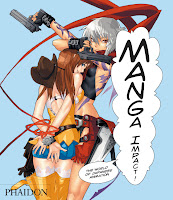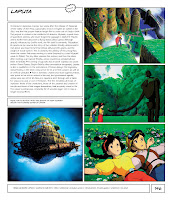“Manga Impact! The World of Japanese Animation” Book Review
–> PURCHASE FROM RAKUTEN.COM (formerly BUY.COM)
–> PURCHASE FROM BARNES & NOBLE
–> Not available for purchase from RIGHTSTUF!
 Manga Impact! is a book which despite its main title has less to do with manga and more to do with anime. Phaidon Press, a British publishing house, has gathered film critics, professors, editors, writers, and other such folks for a more academic book on anime. While I knew none of the names (many are from Europe), these people have been chosen to first write short pieces on various anime directors, anime characters, anime series, anime studios, and manga-ka from A to Z. Many of these short pieces contain color illustrations, some more so than others and there are some that get none at all. Then, each author writes an essay on a topic of their choice from ero-anime to the super robot genre to some pieces on manga and its relation to anime.
Manga Impact! is a book which despite its main title has less to do with manga and more to do with anime. Phaidon Press, a British publishing house, has gathered film critics, professors, editors, writers, and other such folks for a more academic book on anime. While I knew none of the names (many are from Europe), these people have been chosen to first write short pieces on various anime directors, anime characters, anime series, anime studios, and manga-ka from A to Z. Many of these short pieces contain color illustrations, some more so than others and there are some that get none at all. Then, each author writes an essay on a topic of their choice from ero-anime to the super robot genre to some pieces on manga and its relation to anime.
The book also contains a glossary of terms, most of which are “otaku terms” such as shoujo-ai, yuri, youkai, seiyuu, certain Japanese honorifics, etc. There were even some Japanese terms that I’m sure super hardcore fans would know or maybe these are terms that are more commonly used in Europe. The glossary also defines certain animation terms, both in universal animation terms and some that might be specific to anime.
While this is an ambitious project with an attempt to be unique, to me this book falls well short of the mark in a number of areas.
For starters, there’s the simple question of accuracy. Each article about an anime character, anime series, etc. contains an information block which contains the Romaji name of the series, the English name of the series, the director, production company, etc. Unfortunately, when it comes to episode counts, an ongoing series like One Piece simply gets a cutoff episode number rather than an indication that the series is still going on. If there’s an article about a certain anime and then an article about a character from that anime, the episode counts listed might not even be the same.
Further, no information is given on an anime title with multiple series. For example, if you read the article about MISAKI Tenchi from Tenchi Muyo! Ryo-ohki, you’d think that there were only seven total episode based on the info block, although the article makes reference to Tenchi in Love and mentions that that there were unnamed other films and TV series. I would have preferred a complete list of works be mentioned in the info block and I would have preferred that ongoing series be listed as such.
There are other errors as well. For the two articles about Fullmetal Alchemist, the artwork used is from the manga but the book says that the art came from the anime. For the article on Maison Ikkoku (the place in the manga/anime Maison Ikkoku), a cell image of Sakura-sensei and Ataru from episode 154 of Urusei Yatsura is used and the characters are misidentified as Kyoko and Godai. Indeed, after the book was sent to me, I knew the image was in error and a couple of weeks later watched the episode the image came from, which I found rather amusing even if the book error is not amusing.
Because there are a number of errors and incomplete information, it throws the whole book into suspect. If I’m reading about a series, studio, director, etc. I know nothing of, how can I trust what is being written if I see errors for something I do know about? That’s a real shame too because while this is simply a collection of things the various authors wanted to write about, there are a number of classic and very old anime titles mentioned which would be interesting to learn more about. However, is the information given in the book correct?
 I’m not a fan of how the book is formatted either. Every article is simply a block of text with paragraphs denoted by a solid, black oval in the text. I figure this was done to save space and/or to be different, but for me personally, it makes me not want to read what is written. This is especially true on the much longer essay, which are mostly a full page in length vs. the 2-3 paragraphs in the A-Z section.
I’m not a fan of how the book is formatted either. Every article is simply a block of text with paragraphs denoted by a solid, black oval in the text. I figure this was done to save space and/or to be different, but for me personally, it makes me not want to read what is written. This is especially true on the much longer essay, which are mostly a full page in length vs. the 2-3 paragraphs in the A-Z section.
I mention that there are a large number of color illustrations. It is disappointing that some pieces get no artwork and some get an enormous amount of artwork added. As such, whether this was the intent of not, it gives an air of favoritism. As a casual reader, I would assume that the people who put together this book love Gundam (for example) but hate Tenchi Muyo! since Gundam gets lots of references and tons of art but Tenchi gets one article and no art. I wish all of the articles were done like the “Laputa” article shown above (with proper paragraph breaks) but I guess that if they publishers couldn’t get the rights to images for certain titles, there’s not much that can be done about that.
I don’t care for the way the book is bound. Forgetting about the cheap paper it is printed on, the book (measuring 11.3 x 9.8 x 0.9 inches) is very unwieldy. While this is party due to the cheap paper which makes the book limp, it is also due to the fact that the back cover has a fold-out and the front cover not only folds out, but to properly close the book, the front cover also encloses the book with the second part of the cover folding into the book before the back cover. I’m guessing this is done to help protect the book and shore it up a bit on one’s bookshelf.
Ultimately, this book has an ambitious premise to cover anime works and related areas from A-Z but in the end comes off feeling like something slapped together to try to capitalize on the anime and manga craze (such as it is in these tough economic times). Your mileage may vary. ^_^



 March 8th, 2011
March 8th, 2011  AstroNerdBoy
AstroNerdBoy  Posted in
Posted in  Tags:
Tags: 